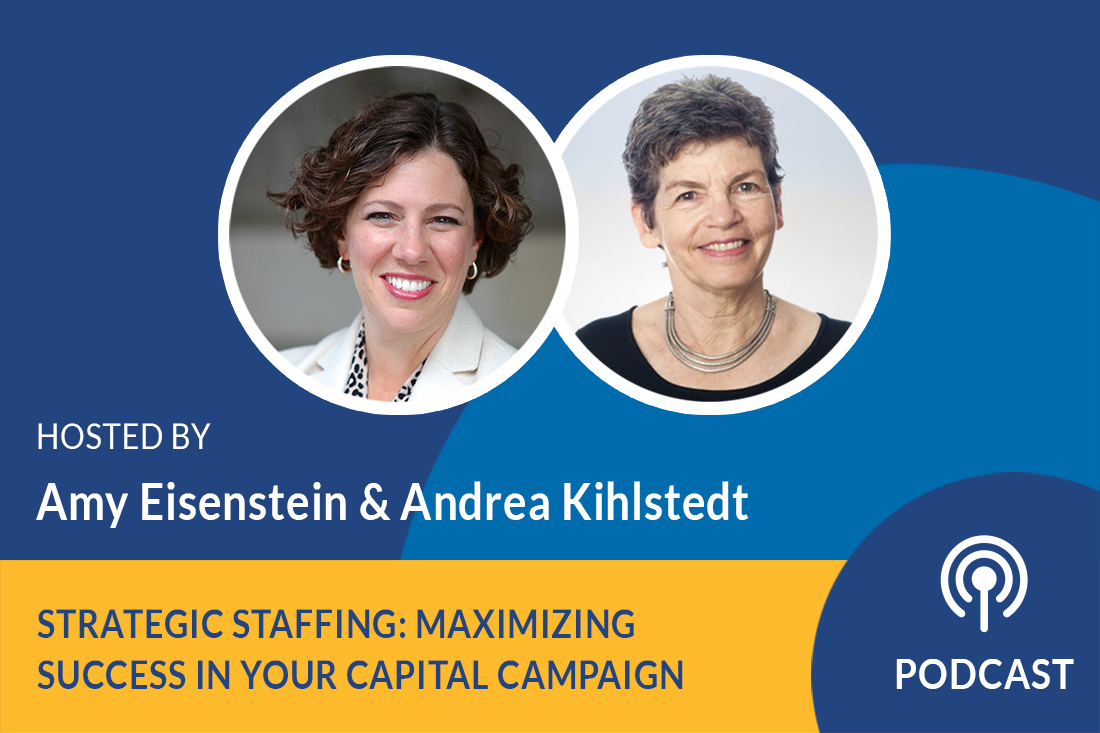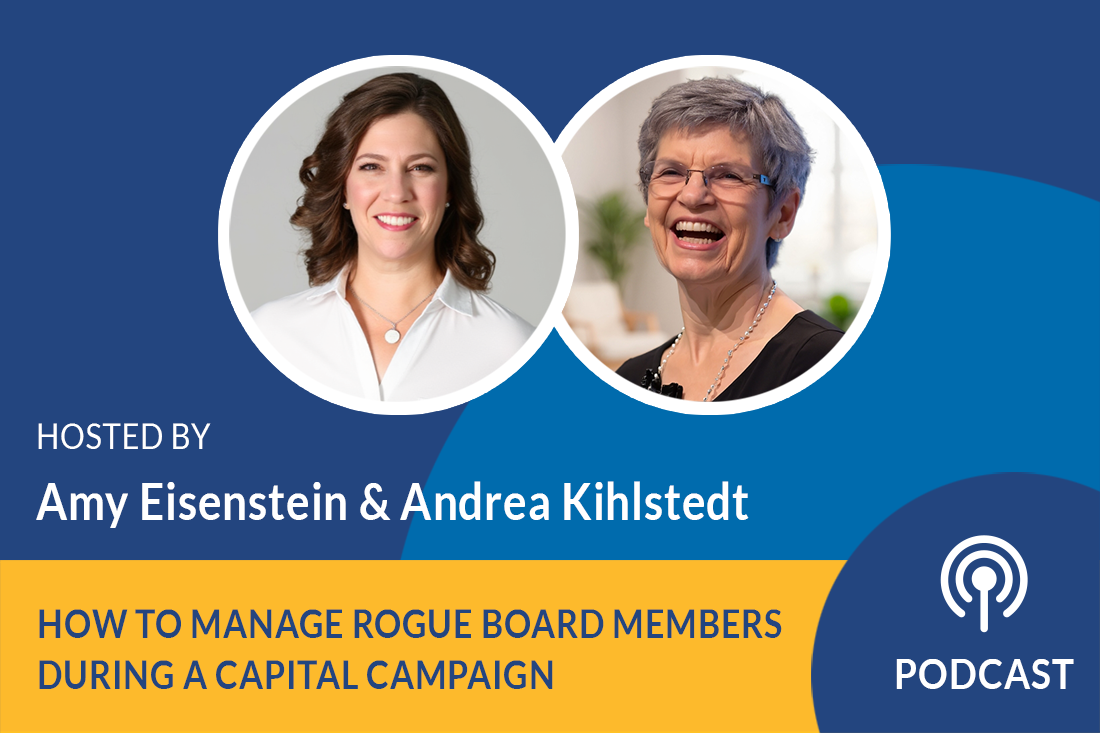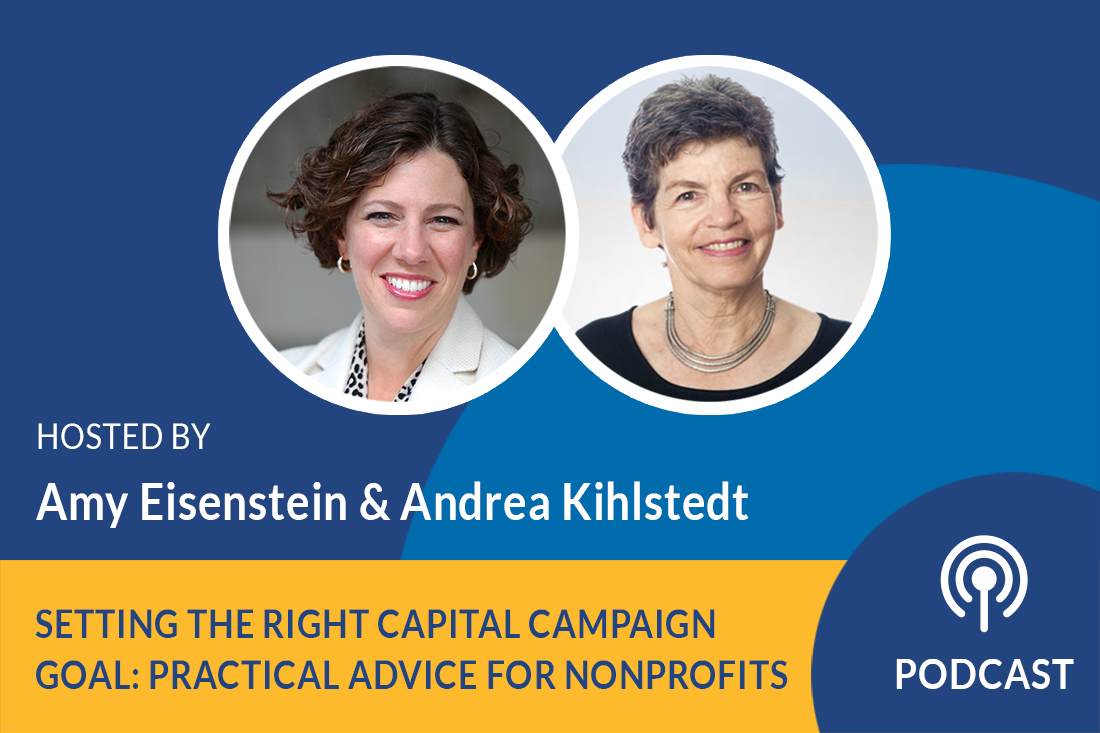Podcast: Strategic Staffing: Maximizing Success in Your Capital Campaign

Season 3, Episode 38
Embark on a journey with Amy Eisenstein and Andrea Kihlstedt as they delve into the critical aspect of staffing for a successful capital campaign. In this episode, they unravel the complexities of determining who does what, emphasizing the need for a well-equipped team to navigate the intricacies of fundraising. Whether you’re a seasoned nonprofit or a founder-run organization, staffing considerations are paramount.
Discover diverse staffing models through real-world examples, including insights from a New York-based organization with an involved executive director and a special projects lead. Amy and Andrea stress the importance of acknowledging your organization’s unique needs and leveraging existing resources. Uncover the art of identifying underutilized talents within your development team and explore the potential to optimize your campaign budget for additional staffing.
Listen Now:
Amy Eisenstein:
If you are thinking about a capital campaign, you are probably wondering about staffing, which is one of the key questions that you need to consider when preparing for a campaign.
Hi, I’m Amy Eisenstein. I’m here with my colleague and co-founder, Andrea Kihlstedt. And today, we are going to talk about staffing for a campaign, and how important it is to know who does what, and make sure that you have adequate hands-on deck, and expertise, and experience and people to do some of the busy work.
How We Advise Our Clients Regarding Capital Campaign Staffing
Andrea, how do you think about staffing and how do you advise clients when they come to you and say:
“How do we staff up for a campaign? Or do we need to staff up for a campaign?”
Andrea Kihlstedt:
Amy, one of the things that makes this a complicated question is that it’s not the same for every organization. It depends on your organization, how and what’s appropriate for you. So, we need to look at a variety of situations. And we were thinking about the various organizations that we work with and we see a bunch of different configurations.
One of the organizations we work with here in New York, actually, the executive director is very involved in the campaign, but the point person is actually a special projects person. He’s not a full-time staff member. He was brought on to run the campaign as a special project and he coordinates with the development director and with the executive director.
Amy Eisenstein:
And with the campaign advisor.
Andrea Kihlstedt:
And with the campaign advisor, exactly. Now, that’s one configuration.
Amy Eisenstein:
That’s interesting. It’s important to acknowledge that we really believe that if you’re doing a capital campaign, if you’re raising twice as much, 10 times as much, 20 times as much as you normally raise for a special project, which is what a capital campaign is, you do need to think about staffing up.
We’re coming at this with the assumption that you don’t have a development team that’s sitting around twiddling their thumbs or an executive director with nothing to do. So, to me the question is, as you pointed out, every organization’s different, how do you need to staff up? What support do you need? So, I wanted to set the stage a little bit. I think we dove right in, so keep going.
Andrea Kihlstedt:
So, Amy’s exactly right. I mean, every time we sit with a board and they say, “Well, do we need to staff up for a campaign?” I feel like saying to them, “When was the last person you saw… The last time you saw your development director twiddling his or her thumbs in their office, wishing they had something to do?”
Of course, that’s ridiculous because every development director, every development person is working like mad to bring in the annual revenue for the organization. So, it’s absurd.
Before Staffing Up for Your Campaign, Look at Your Current Staff
How do you expect to raise so much money without bringing in someone else? The question is who to bring in to be most effective, most cost-effective, but more importantly, most effective for your campaign.
And as I was saying there, what makes it complicated is that there’s not one clear answer, other than this. Someone does need to be the point person for your campaign. That can’t be no one, sort of like whoever feels like doing campaign is going to do campaign. That doesn’t work. So, you need someone who’s going to do that.
Consider the Capacity of Your Development Shop
Now, in the organization that I was talking about before, they actually hired a special projects person to be the point person for the campaign. In other organization that we work with, which is a founder-run organization, it’s a fairly significant organization, but the founder is still there. And the founder actually is the point person for the campaign, and he works with the development director and support staff for the development director for the campaign.
It’s sort of like a team, but it’s really led by the founder because he has such a special relationship with his donors and with fundraising in general. He’s just very, very involved with that.
So, those are two radically different approaches and they’re not the only approaches. What we have found however, is that a good place to start when you think about staffing up for a campaign is, first of all, to look at what the capacity of your development shop is:
- Who do you have?
- What’s covered; what’s not covered?
- Are there people in your development shop who are underused, who they may be busy but they may not be working at the top of their capacity?
They may have the ability to take on something big, bigger and more demanding. Maybe someone like that would be a great campaign manager or director and then you would hire underneath them, if you had someone like that.
It’s likely that in your development shop you don’t have enough support staff. We see that all the time, campaign or no campaign, people are doing support staff work who would be better served being out and doing work with donors. So, we always like to say:
“Well, why don’t you spend a week having every staff person in your development office write down what it is they do, everything they do in a week, and then each person should circle the things that they don’t have to do that someone with a lower-level skillset could do?”
That’s always really revealing that everybody looks at their lists and says:
“We could hire a support staff person to do this, that and the other thing, so the people we already have on board could move up to higher level, major gifts work or campaign work.”
So, what I’m trying to say in a lengthy way is the first thing to do is look at your current staff. Be sure you know who’s doing what. Be sure you understand who’s underused, who has the ability to move up into a more demanding role. Look and see where you have opportunities for people at lower levels to function, if you could bring them in.
Amy Eisenstein:
Yeah, I think you’ve made some really good points. During a campaign, you want to lean as heavily as you can on the existing staff that already have relationships with donors. And so often, the majority of the campaign work does fall to the executive director. You gave a good example of a founder who’s leading the charge on their campaign.
Development Directors Make Excellent “Lead Point People”
And sometimes I can think of a handful of clients that we work with, that use their executive director or their founder as the lead point person for the campaign. Very frequently, of course, it’s the development director. And so, to me, this is an amazing opportunity for development director to really shine, to increase their skills, improve their skills, try new things that they’ve never done before. Most development directors probably haven’t run a campaign from start to finish. It makes them so much more valuable as an employee to successfully have run a campaign.
And this is an opportunity for them to hire under them, as you said. It might be an administrative person. It might be they might outsource some grant writing if that’s what they’ve been doing. Or if they’ve been planning a lot of events and galas, maybe they’ll hire an event coordinator or an event planner. It might be part-time, it might be full-time.
But really, I mean, I think our overall point is that there needs to be a point person, somebody who’s running the campaign and you are going to need to staff up. Because it’s very unlikely that with your current staffing, you’re going to be able to raise two times, five times, 10 times what you’ve been previously raising. So, it just makes sense.
Capital Campaign Experience is a Must
In addition, of course, to some expertise, it’s likely that you’ll need some campaign expertise as well.
Let me just go back to your very… I love this exercise where you have staff members write down what they do for a week and then circle things that they can delegate or outsource. It always makes me laugh. Every once in a while, we get an executive director or maybe a development director who doesn’t circle anything. They can’t imagine giving anything away. It makes me laugh, because I just tell those people they’re control freaks. It doesn’t work for them to grow the organization, if you have to keep everything close that you’re doing.
So, there are things that can be outsourced. There are things that can be delegated. And the question is, how will you hire in order to make your campaign a success?
Andrea Kihlstedt:
I think that’s a great exercise for everybody, actually, Amy. Every once in a while, once a year, once every six months, to really list all the stuff you do and see what you can move off your plate. It’s just a good idea to do that sometimes.
Do You Really Need to Staff Up for Your Campaign?
What we haven’t talked about yet, Amy, and I think it’s so important, is that whether or not you really must staff up. And we think it’s a good idea, but whether or not you really must staff up.
A campaign gives you a remarkable opportunity to staff up, because the campaign has a budget. Early on in your campaign, you should get a budget approved by your board, by your executive director, of money that will be spent specifically on the campaign. And that should include a line item for additional staffing.
Now, for the period of the campaign, that means that you don’t have to be spending money out of the operating budget for your organization to hire some additional staff. And that’s a wonderful opportunity. Now, it isn’t long-term.
Let’s say your campaign is going to be three years, that may bring someone on for a three-year period. But if you’re clever, you can start them out at full-time on the campaign budget. And gradually, each year, the organizational budget, the operating budget picks up a little more. So, by the time of the end of the campaign, actually, the campaign budget isn’t covering their salary at all, but the operating budget is. So, you have tidily shifted somebody from the campaign budget to your operating budget, and then you get to keep that person over time. It’s an amazing opportunity.
The Trojan Horse Effect
With campaigns, I’ve often thought of campaigns as being like Trojan horses. And if you know the old story about the Trojan horse, which was outside the gates of Troy. And they rolled the Trojan horse inside the gates, and then all the men who were hiding inside the belly of the horse came out and battled. Now, campaigns are like Trojan horses, because you can accomplish a lot more than just raising the money. If you’re clever, you can use your campaign to strengthen your development shop, to put together new systems, to invest in your development programs, to bring on additional staff, to switch things around.
It may be that your staff was stuck with people not precisely in the right positions. The campaign in its Trojan horse mode, it gives you an opportunity to say:
“Okay, we have new needs. Let’s look at how everyone functions and what it is we need.”
And lo and behold, your development shop starts to function better. So, take advantage of that Trojan horse function of a campaign.
Free Resources to Help You Determine Your Campaign Needs
Amy Eisenstein:
I love that. So, let me point listeners to our website for some free resources. So, if you’re interested in assessing your development’s shops, system, infrastructure, staffing, before you head into a campaign, go to the Capital Campaign Pro website. And for free under our resources page, there’s a development office assessment and it will ask you lots of questions so you can start to think about what you need. Not just staffing, but staffing is one key component of it, but also systems and infrastructure, to see if you’re ready for a campaign.
Now, if you’re really ready for a campaign and ready to get our resources, maybe before you work with a consultant or you’re thinking of doing it yourself, we have a whole bunch of do it yourself support on our website as well.
So, do visit capitalcampaignpro.com for all sorts of free and not free membership resources. All right.
Final Thoughts About Campaign Staffing
So, final thoughts about staffing. So important to staff up. You have board members or maybe your executive director, not sure you need to staff up, send them over here to listen to this episode. Andrea, what do you want to say about staffing?
Andrea Kihlstedt:
I want to say three [two] things. I want people to think about three [two] things that we have covered:
- One is a campaign is an amazing time to staff up, and you can do it within the context of your campaign budget. So, don’t miss that opportunity. No matter how you’re feeling about your development shop, don’t miss the opportunity to strengthen and improve your development shop through a campaign by using that campaign budget function. That’s number one.
- Number two, there is not one model for staffing up. How you’re going to staff up depends on where the power, and strength of your organization is and what roles your executive director wants to play or your board chair wants to play. So, take a close look at how you’re currently configured, and then come up with a plan for staffing up that takes into consideration what it is your organization really needs and what’s going to work for your organization.
And number three, I’ve forgotten what number three is, Amy.
Amy Eisenstein:
I think two is good.
Andrea Kihlstedt:
Two is good.
Amy Eisenstein:
Staff up. All right, guys. Well, thank you so much for joining us and we’ll see you next time on All About Capital Campaigns.



Leave a Comment